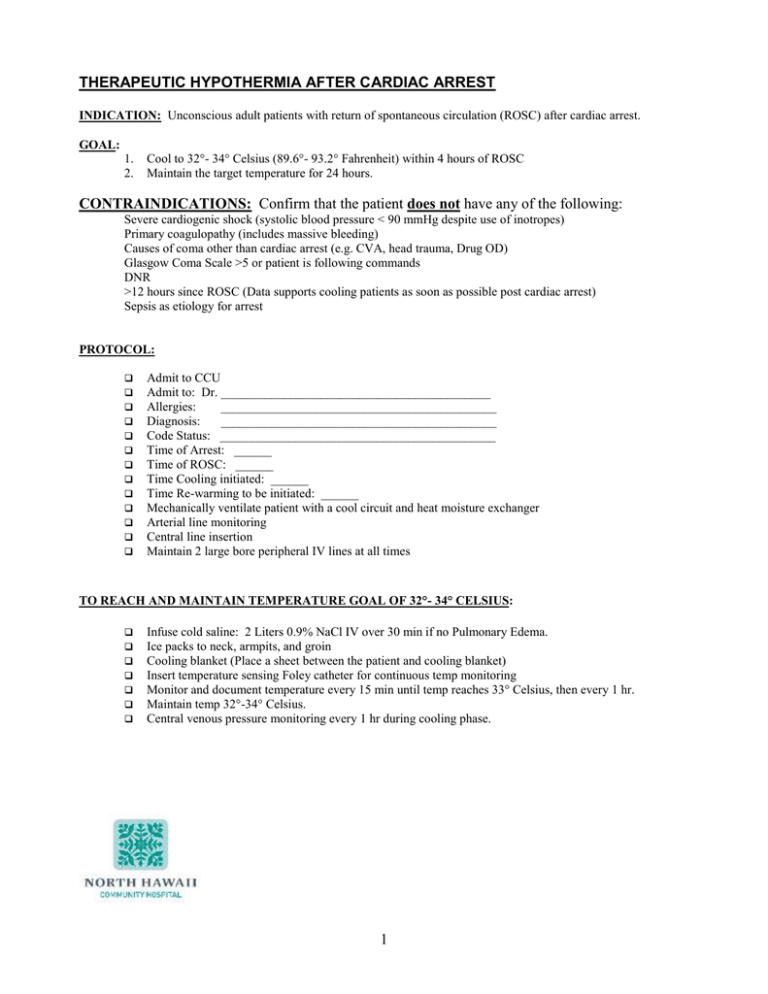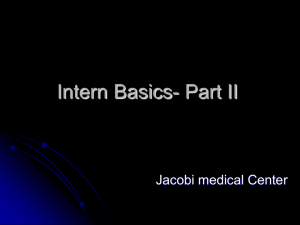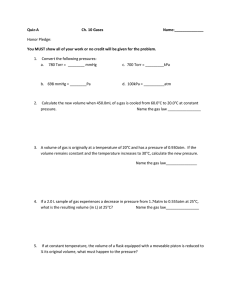THERAPEUTIC HYPOTHERMIA AFTER CARDIAC ARREST
advertisement

THERAPEUTIC HYPOTHERMIA AFTER CARDIAC ARREST INDICATION: Unconscious adult patients with return of spontaneous circulation (ROSC) after cardiac arrest. GOAL: 1. 2. Cool to 32°- 34° Celsius (89.6°- 93.2° Fahrenheit) within 4 hours of ROSC Maintain the target temperature for 24 hours. CONTRAINDICATIONS: Confirm that the patient does not have any of the following: Severe cardiogenic shock (systolic blood pressure < 90 mmHg despite use of inotropes) Primary coagulopathy (includes massive bleeding) Causes of coma other than cardiac arrest (e.g. CVA, head trauma, Drug OD) Glasgow Coma Scale >5 or patient is following commands DNR >12 hours since ROSC (Data supports cooling patients as soon as possible post cardiac arrest) Sepsis as etiology for arrest PROTOCOL: Admit to CCU Admit to: Dr. ___________________________________________ Allergies: ____________________________________________ Diagnosis: ____________________________________________ Code Status: ____________________________________________ Time of Arrest: ______ Time of ROSC: ______ Time Cooling initiated: ______ Time Re-warming to be initiated: ______ Mechanically ventilate patient with a cool circuit and heat moisture exchanger Arterial line monitoring Central line insertion Maintain 2 large bore peripheral IV lines at all times TO REACH AND MAINTAIN TEMPERATURE GOAL OF 32°- 34° CELSIUS: Infuse cold saline: 2 Liters 0.9% NaCl IV over 30 min if no Pulmonary Edema. Ice packs to neck, armpits, and groin Cooling blanket (Place a sheet between the patient and cooling blanket) Insert temperature sensing Foley catheter for continuous temp monitoring Monitor and document temperature every 15 min until temp reaches 33° Celsius, then every 1 hr. Maintain temp 32°-34° Celsius. Central venous pressure monitoring every 1 hr during cooling phase. 1 MEDICATIONS: SEDATION: Titrate to maintain a Modified Ramsay Sedation Scale Score of 3 to 4 to prevent shivering. Diprivan: Initiate drip at 3 mcg/kg/min. Fentanyl: Initiate drip at 25 mcg/hr. Midazolam: Initiate drip at 4 mg/hour. If shivering occurs despite sedation, initiate paralytic to prevent shivering. Titrate to maintain Train-of-Four of 2 out of 4. Vecuronium (1 mg/ml) Initial dose 0.1 mg/kg IVP bolus, then initiate drip at 1 mcg/kg/min. Rocuronium (1 mg/ml) Initial dose 0.6 mg/kg IVP bolus, then initiate drip at 4 mcg/kg/min. Lorazepam 1 mg IV prn seizure. May repeat every 15 minutes x 3 doses. If seizure continues contact MD. Levetiracetam 1 Gm every 12 hour IVPB if patient has seizure activity Opthalmic Lubricant Ointment 3.5 Gm. 1 application to both eyes every 6 hours. Pantoprazole 40mg IVPB q 24 hours DVT prophylaxis: SCDs Enoxaparin 30 mg SQ q 24 hours Enoxaparin 40 mg SQ q 24 hours Heparin 5000 units SQ q 12 hours Maintain the Mean Arterial Pressure (MAP) 70-90 mmHg For MAP less than 70 mmHg: Give 0.9% NaCl 250 cc IV bolus over 15 minutes. If MAP still <70 after NS bolus completed begin Norepinephrine Infusion (4mg/250 ml) at 2 mcg/min, titrate to maintain MAP 70 – 90 mmHg. For MAP greater than 100 mmHg: Labetalol 10 mg IV q 4 hours for MAP > 100 Labetalol 20 mg IV q 4 hours for MAP > 110 Hydralazine 10 mg IV q 4 hours for MAP > 100 Hydralazine 20 mg IV q 4 hours for MAP > 110 Diltiazem 10 mg IV then initiate Diltiazem drip at 5 mg/hr Esmolol: Initial bolus 1mg/kg over 30 seconds and initiate drip at 150 mcg/kg/min Nitroprusside: Initiate drip at 0.25 mcg/kg/min and titrate to maintain MAP 70 – 90 mmHg IV Fluids: 0.9% NaCl @ 75cc/hr 0.45% NaCl @ 75 cc/hr LR @ 75 cc/hour ______________________ If Potassium less than 4.0, give 20mEq KCl rider IVPB (requires a central line) If Potassium less than 3.5, give 20mEq KCl rider x 2 IVPB (requires a central line) If Potassium less than 3.0, call MD for orders NO TPN or Enteral Feeding 2 ADDITIONAL ORDERS: Vital signs per CCU protocol Insert and maintain NGT or OGT to intermittent low suction Strict I & O Neurology Consult Cardiology Consult Keep Head of Bed (HOB) at 30° Portable CXR q AM Brain CT to rule out intracranial hemorrhage or other causes of coma, if not done in ER. EEG STAT ECG STAT q AM ECG STAT for change in rhythm Continuous End Tidal CO2 monitoring. Goal: EtCO2 35-40 mmHg Continuous pulse oximetry to keep O2 saturations between 94 – 99% CBC, BMP, Phosphorus, Magnesium, PT, CK, CKMB, Troponin q 6 hrs x 24 hrs ABG q AM UA, Urine Culture, Sputum Culture, Blood Cultures x 2, if not done in ER. Beta HCG on all women of childbearing age, if not done in ER. LABS: RE-WARMING: Begin re-warming 24 hours after initiation of hypothermia Re-warm to 37° Celsius over 12 hours. Increase core temp slowly (approximately 0.5° Celsius per hr) If K+ >3.5 when re-warming is initiated, DC all fluids containing Potassium. Stop infusion of paralytic medication after temperature reaches 96.8° Fahrenheit Neuro checks during re-warming phase: every 1 hr x 4, then every 4 hrs x 24 hrs. Remove all cooling devices Place Bair Hugger warming device PRN BMP every 6 hours x 24 hours Morphine Sulfate 2 mg IVP q 1 hour PRN shivering. Morphine Sulfate 4 mg IVP q 1 hour PRN shivering. Give Acetaminophen 650 mg PR q 6 hours if temperature > 99° Fahrenheit within 12 hours after rewarming. If temperature remains > 99° Fahrenheit use cooling blanket to actively maintain temperature of 98.6° Fahrenheit. MD Signature: __________________________________________ Date and Time: ___________________ Revised: 12/10/12 ________________________________________________________________________________________________ 3


